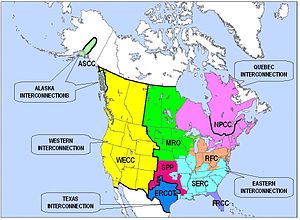
Hydro-Québec's electricity transmission system (also known as the Quebec interconnection) is an international electric power transmission system centred in Quebec, Canada. The system pioneered the use of very high voltage 735- kilovolt (kV) alternating current (AC) power lines that link the population centres of Montreal and Quebec City to distant hydroelectric power stations like the Daniel-Johnson Dam and the James Bay Project in northwestern Quebec and the Churchill Falls Generating Station in Labrador (which is not part of the Quebec interconnection).
The system contains more than 34,187 kilometres (21,243 mi) of lines and 530 electrical substations. It is managed by Hydro-Québec TransÉnergie, a division of the crown corporation Hydro-Québec and is part of the Northeast Power Coordinating Council. It has 17 interconnectors with the systems in Ontario, Newfoundland and Labrador, New Brunswick, and the Northeastern United States, and features 6,025 megawatts (MW) of interconnector import capacity and 7,974 MW of interconnector export capacity. ( Full article...)